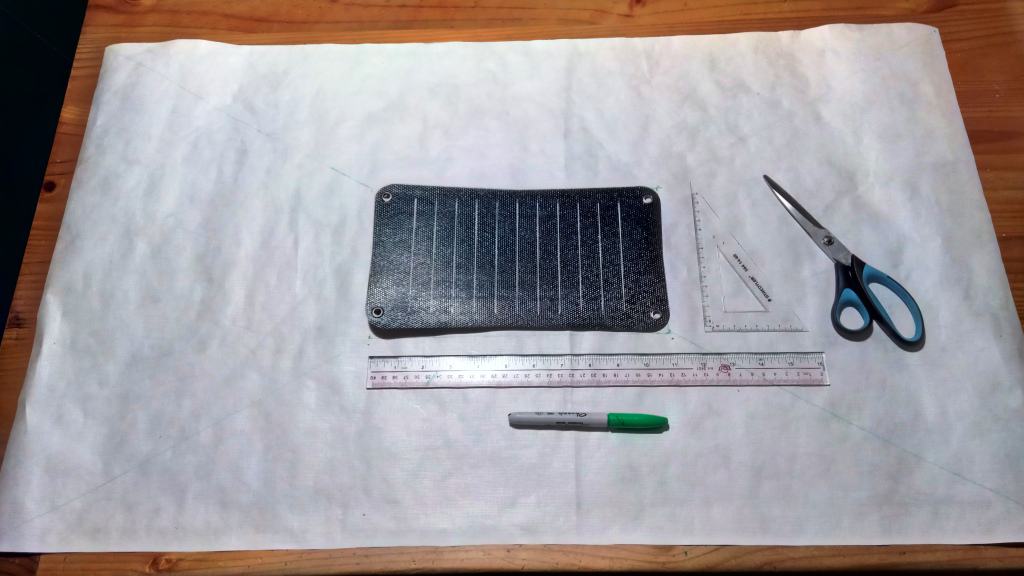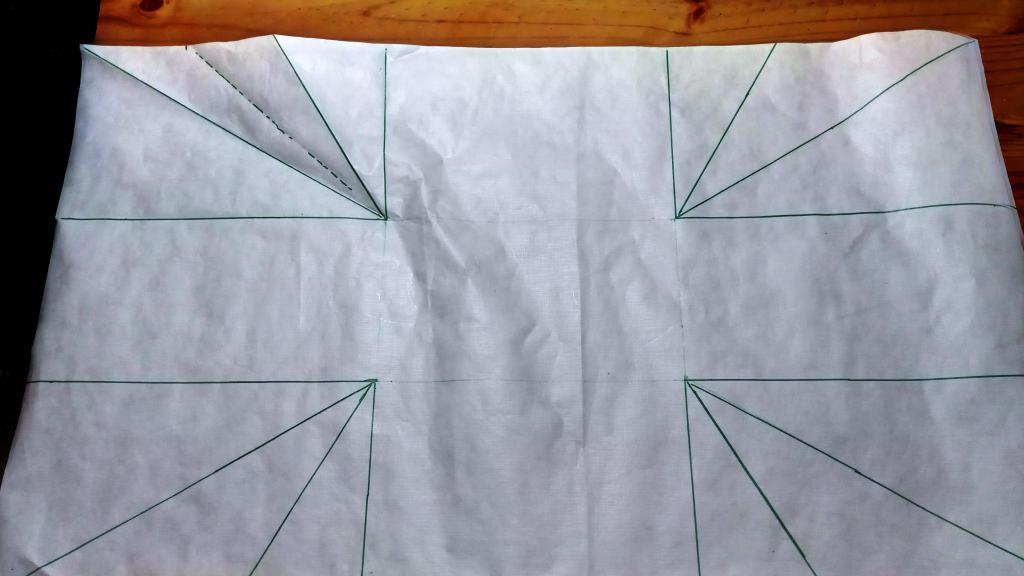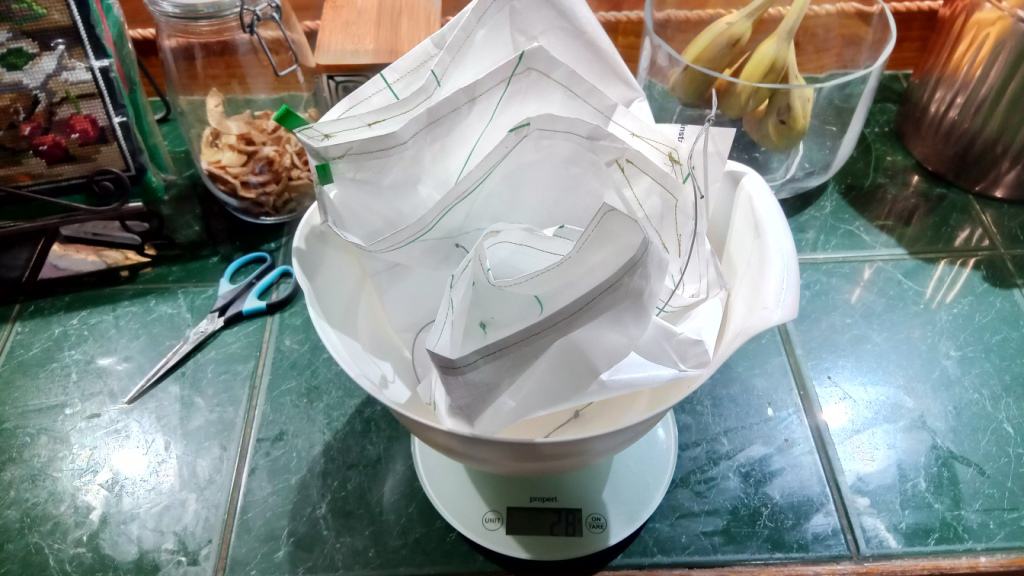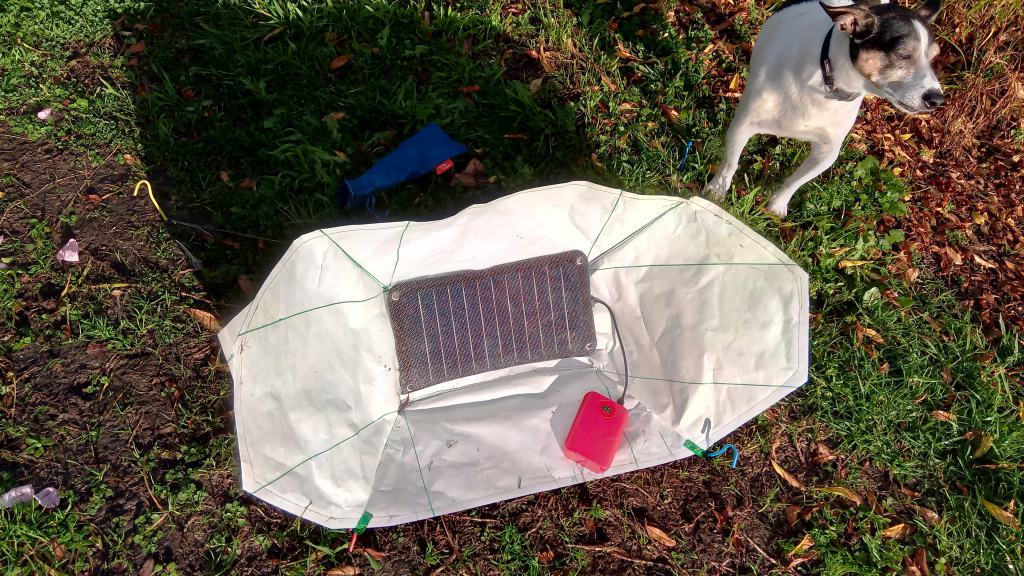The wonders of Tyvek once again! This device boosts the electrical output of my solar panels by approximately X+ times (and weighs approx 28 grams). Tyvek reflectivity is just about as good as it gets: 97% eg as compared with white titanium dioxide paint at 95.5% so it is perfectly suitable for this application.
The reflector has approx 6 times the surface area of the panel, so I am hopeful I will get a significant boost. I may not get such a good result out of this prototype because the output of the panel may be amperage limited – so too the batteries I am trying to charge. If I get significant improvement I will be trying a larger version whose solar panel has two outlets, and I will move on from there.
I have been playing with making ‘hiking electricity’ for some time. Let me tell you it is a fraught field but I am making some progress. More reports to come. Much of what I have been doing has been comparing various solar panels (unbelievable differences) but I have also noticed that there are other limiters. I have already mentioned cables for example. There is much to learn.
At the moment I am fairly happy (relatively) with the performance of a couple of Buheshui panels but today I wanted to explore whether I could squeeze more power out of them by pouring some more light into them – hence the reflector build.
Here where we live (at Jeeralang Junction in Southern Victoria’s wonderful; Gippsland – the very best place in the whole world!) we are at 30 and a bit degrees South which means that the sun is now only about 30 degrees above the horizon, so a panel has to be tilted 30 degrees from the vertical or 60 degrees from the horizontal to interrupt light at 90 degrees – which is optimal. The reflectors in turn need to be tilted relative to the solar panel at about 60 degrees so that their light is reflected onto them, and at a reasonable angle.
I started with a piece of Tyvek Homewrap a bit more than 3 times the width and height of the chosen 10 watt solar panel (150 grams).

I marked out the panel in the centre , the bottom, top and side reflectors. The corners need to be folded in 1/3rd so that the resulting surfaces are all at 60 degrees from each other.

Then folded and sewed

Till I got this. Now it needed bits cutting off, hemming and tie-outs.

Finished it weighed 28 grams – though the photo fails to show it.

And takes up this much room (next to a Mini-Bic) in your pack – about the size of a matchbox.

Spot is very interested in electronics and indeed all things hiking and hunting – as I imagine you have noticed. Here in Southern Vic the front reflector can pretty much sit on the ground at this time of the year. You need to set it up so that its shadow is longest and directly behind it. It can be tilted with tent pegs and string for different latitudes/times of year.

Here is a rear view. These three cell chargers are beaut as they give a percentage charged read-out. I have also ordered some cheap USB amperage digital gauges which should provide me with more information.

And a side view. BTW: Those are Tito’s 6.5″ Shepherd’s Hook titanium pegs from Aliexpress for about US$1.20 each delivered and 5.5 grams. I find them very good. They have easy to see brightly coloured ends – nonetheless I have already lost one on this single project!

Today we had an inch of rain and just this brief five minutes of sunshine. There won’t be any significant sun for a few days, so you will have to check back for results.
PS: I realise that a foreshortened version of this idea will work on top of my pack. Keep an eye out for it when I make the prototype – soon. I will get 1.5- 2 times the output from my solar panel when actively hiking in this way – a big boost at very little weight penalty. Probably no more than ten grams in Tyvek; or 40% of that in an ultralight .77 oz/yd2 white polyester. Preliminary result 12/05: It has been a very dull morning, but for the last three hours the panel without the reflector is charging at less than half the rate of the one with!
You can see the extra light on the panel with the reflector.

See Also:
https://www.theultralighthiker.com/2020/02/21/amps-are-everything/

Fantastic idea, I think I’m going to create a reflector for my lixada “10w” panel. Do you reckon the increased concentrated sunlight might possibly damage/melt the panel on a hot day? Thanks. Have you experienced any melting on your panel? Cheers.
No, I don’t think it will but the panel will be amperage limited so the reflector will work less and less well as you approach the amperage limit, ie it will work better when there is less sun unless you can change the circuit to increase the amperage. Read he connected post Amps are Everything.
Hi Steve, I have been tinkering with a sun pointer (https://timtinker.com/solar-fire-blower/). Now I am tinkering with reflectors to get a little extra out of my backpacking solar panel. What is the optimal internal angle between the panel and the Tyvek? I come up with 30 degrees from my calculations and tests. That seems to be the best angle that I can find (same as our sun angle and the slope of my A-frame roof).
Also, do you think that the reflection of sunlight from your Tyvek reflector is dispersed or diffuse reflection (less effective as it goes in all directions: https://en.wikipedia.org/wiki/Diffuse_reflection ) as compared to that from a flat silver ‘mirror-like’ reflector? If your reflection is diffuse, I think it will have the advantage of working with a much bigger reflector as the angle is much less critical. Did you try a giant Tyvek sun trap just for fun?
So far, I can get a 43% improvement by adding a shiny flat reflector (about the same size as the panel) to one long side ( 0.335A with no reflector & weak afternoon sun up to 0.4875A with a single side flat reflector). I don’t know if I can make it practical for backpacking? My idea was to be able to get more energy into the battery during a lunch break etc, rather than using it in this way on my pack.
I would be interested in your thoughts.
Regards,
Tim
Hi Tim, As usual your scientific brain and ingenuity are likely to take this idea of mine much further much quicker than I ever would have. Mine was a one day wonder really which I have meant to revisit. I bought a slightly larger better solar panel which I also intended to make a reflector for. I also intended to add a reflector to a backpack model. Its dimensions would be constrained by the width (of the person) and the height available and the need to be able to walk through the bush with it but I figured one could anyway at least double the panel’s output even then – which you have proved. Those little USB meters (https://www.theultralighthiker.com/2020/05/30/keweisi-usb-amp-tester/) are handy aren’t they? The tyvek is a very reflective inexpensive and reasonably robust material. I can let you have a piece of you don’t have any.The 18650 battery will accept more than the 1 amp which the panel is constrained to with the charging circuit it comes with. I bought a couple of 2 amp circuits from Aliexpress for a couple of bucks to improve them but I haven’t done so yet. Morning before you set out, lunch break, afternoon while you set up camp, say 3 hours sun – if you can double or quadruple the output you might well provide yourself with an adequate power source from a panel which might only weigh 100 grams or so. Cheers, Steve.
Hi Steve, My solar panel has an output rating of 2.1A at ~5V. Yours looks very similar. So that seems to be quite OK with my intended solar boosting with up to 4 reflectors that each can add about 0.15A to the base current of 0.33A in afternoon winter sun. I doubt it will exceed 2.1A. I don’t understand why you need the extra electronics or am I missing something?
Also, thanks for the offer of the Tyvek.
I made the mistake of washing my Tyvek ground sheets. It made them nice and soft, but the surface has gone hairy and they now hang onto pesky bits of grass and seeds etc (https://timtinker.com/tyvek-groundsheet-ideas/). So I will have to get a serious amount to replace them. Is Bunnings the best place to get it? Mine was leftovers from a building job.
Regards,
Tim
Maybe you have a larger heavier panel. I thought the one in my photo only outputted 1 amp but it is a long while ago and I will have to check. I do have one which outputs more – or at least it has two equal outlet USBs so it would suit boosting with a reflector more. I also bought some USB double adapters hoping I could draw off twice as much but I haven’t tried that either. I wanted a lot more current than I could practically get with solar and in conditions where solar is unlikely to work at all which is why I want to try the Peltiers but have not done so yet. I usually buy a 30 netre roll of Tyvek from Bensons Home Hardware in Morwell at about $200 last time I bought one. I have used most of it up. It is the 2 oz weight. Backpacjkinglight.com.au have the lighter weight.
Hi, so how is your long term experience with the Tyvek reflector? Did you find it usable? Why did you hem the edges?
I always hem the edges. It gives them a bit of stability and something to attach tie-outs to. Frankly I have just about abandoned solar as an idea -as I think the world should. It is just not available at the right time and too diffuse to be much use. I am going for a thermo-electric generator from burning wood as my hiking charging solution – but I haven’t built my own yet. That being said you can easily double the amount of energy available to your panel with this simple device. One problem with that is that the panels are amperage controlled (at 2 amps) so often you can’t use it. I have bought a citcuit to increase the amperage to four but I may have to split it between two chargers as many batteries don’t want to accept four amps. Cheers, Steve.